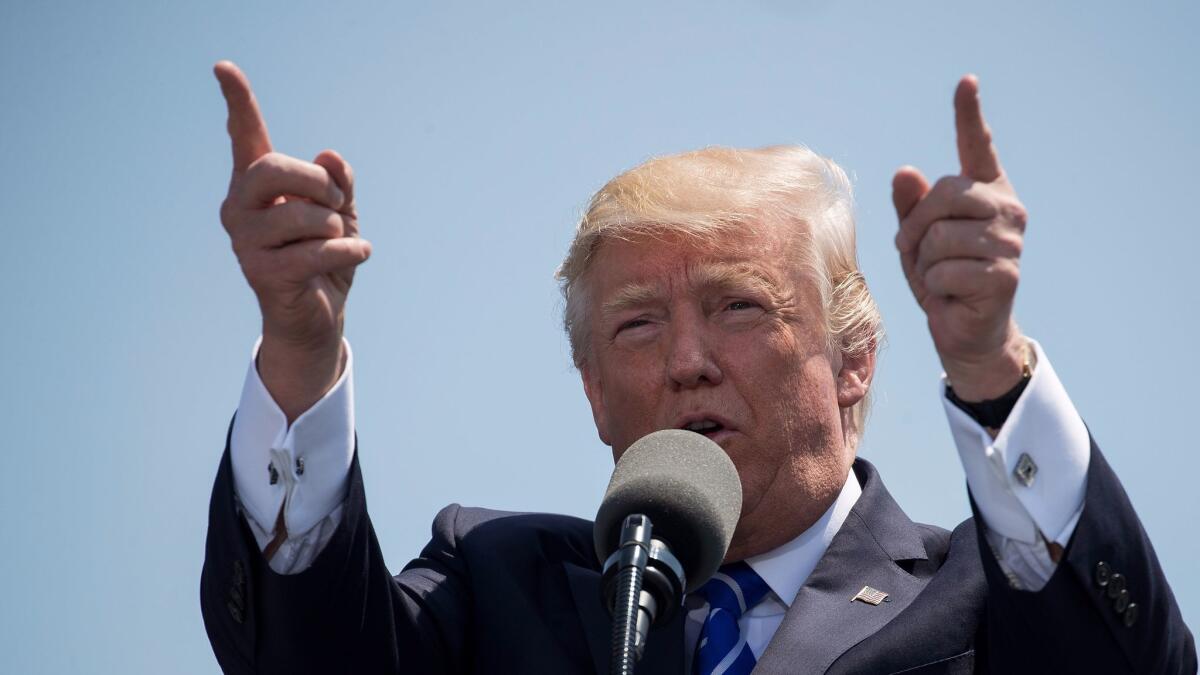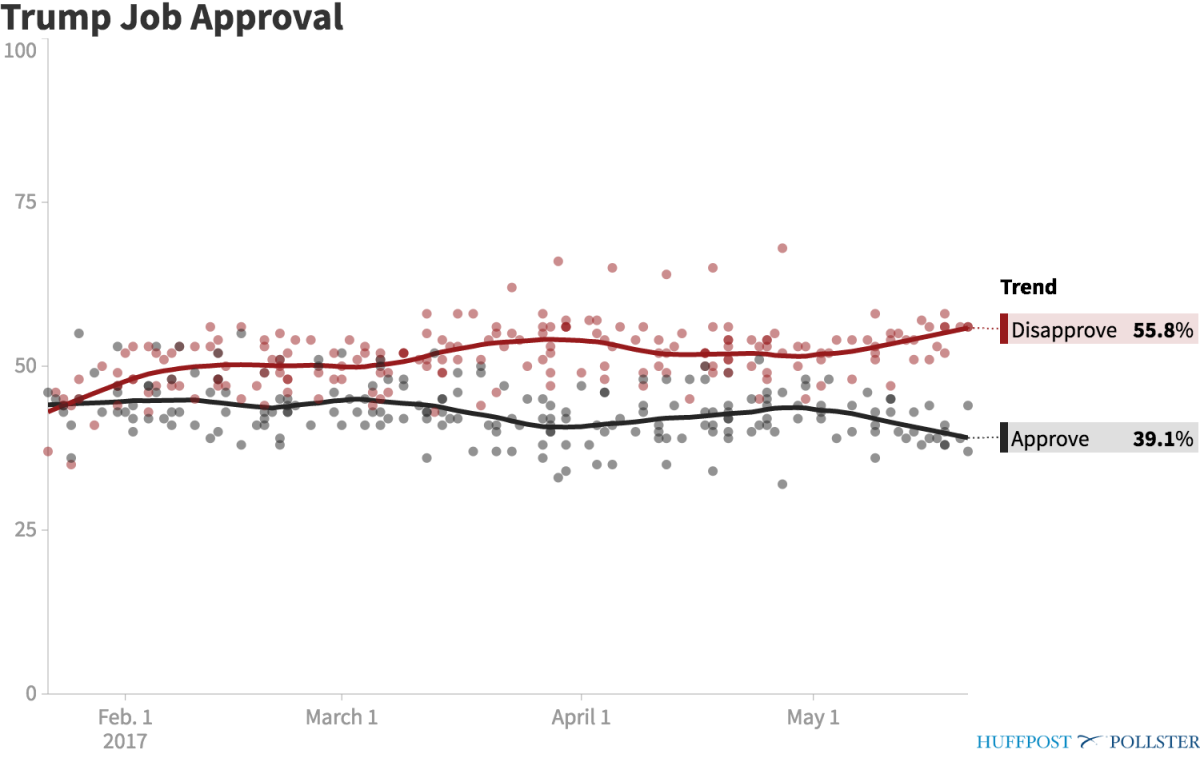Q&A: Trump’s standing in polls has dropped: How significant is the slide?

President Trump’s standing in national polls has consistently declined since the end of last month. His approval rating now sits at the lowest point of his presidency. Here are some questions and answers about what the polls do — and don’t — tell us.
How significant is Trump’s slide?
At the end of April, the share of Americans who disapproved of Trump’s job in office outnumbered those who approved by about 8 percentage points in polling averages.
That gap has now doubled. That’s a lot.
The percentage who approve of Trump’s job performance is now below 40% in the two major polling averages, done by Real Clear Politics and the Huffington Post. He’s at the lowest level of his presidency so far and far lower than any previous president at this point.
What do the most recent polls show?
Surveys in the last week range from Gallup’s tracking poll, which shows 37% of Americans approving of Trump’s job performance and 56% disapproving, to a Rasmussen poll of people deemed likely to vote in 2018 that has 44%-56%. Surveys by all the major polling organizations show roughly the same downward trend in Trump’s approval.

Keep up on all the latest news on the Trump administration »
What’s driving Trump’s numbers down?
We don’t really know. Polls, as snapshots in time, can’t readily track people’s reasons for changing their minds. But the timing gives us some strong clues.
Trump’s slide began around the time the House started to debate the latest version of the GOP healthcare bill. We know from separate polling that Trumpcare, as Democrats call it, is extremely unpopular.
Odds are that the healthcare bill has played a big role in Trump’s slide.
Firing FBI Director James B. Comey and the appointment of Robert S. Mueller III as special counsel to oversee the investigation of Russian interference in the 2016 election surely didn’t help Trump’s standing. But while those events got a lot of headlines, the voters who follow that kind of news tend to be people who pay a lot of attention to politics. Most of them already have strong opinions of Trump and aren’t likely to change.
Healthcare, by contrast, touches the lives of a lot of people who don’t pay attention to politics. They’re the voters more likely to change their minds.
What do we know about who has turned against him?
Compared with his showing in late April, Trump has lost ground among self-identified independents and, to some degree, self-identified Republicans. His standing among self-identified Democrats is so low in most polls that it doesn’t change much any more.
Trump remains more popular with older Americans, especially those older than 65, than with those younger than 45. And he’s more popular with whites than minorities.
In polling by SurveyMonkey, which collects very large samples that allow detailed analysis, Trump’s support has dropped 10 percentage points since late April among white voters who did not go to college — a group that was key to his victory last fall. That’s a potentially worrisome development for Trump.
Trump lost 6 percentage points among white college graduates, and his standing among nonwhites, which was already low, did not change significantly.
Trump was unpopular in the fall, but got elected anyway. Does his standing in polls matter?
Yes, it does, especially to members of Congress.
In the fall, Trump was running against a Democrat, Hillary Clinton, who was also very unpopular. A significant bloc of voters disliked both of them, and a majority of those voters made up their minds for Trump.
The situation has changed: Now polls are a straight-up gauge of Trump’s standing, and he, of course, won’t face voters again until 2020. But members of the House, and one-third of the Senate, will be up for election in just over 17 months.
Historically, when presidents are unpopular, voters in midterm elections turn to candidates of the opposing party to act as a check on the White House.
Are there other hints about how the midterms might go?
Yes, there are two sources of information.
First, there are off-cycle special elections to fill vacancies in Congress. This spring features several such elections, including one this week for Montana’s at-large congressional district and one next month in a suburban district outside Atlanta.
Special elections can give us some sense of how voters are reacting to events, although they’re not always a reliable guide.
The other source of information are polls that ask people which party they would like to see win in the next congressional election. So far this month, Democrats have led in that so-called generic-ballot question by an average of about 8 percentage points.
In the last couple of decades, as Democrats have come to rely more on young and minority voters, who often skip non-presidential elections, they have tended to suffer in midterms from lower turnout than Republicans. Because of that, they need a significant lead in the generic ballot if they are going to take control of the House.
Democrats probably would need a double-digit lead in generic-ballot polls to have a solid shot at retaking control of the House, although no one knows for sure. And, of course, we don’t know whether their current lead will build or shrink as the election gets closer.
Don’t polls have a bad record of tracking Trump’s support?
No, they really don’t.
In November, most national polls were quite close on the popular vote, which is all a poll can forecast.
There were a handful of states in which polls were off by a few points. As luck would have it, they were off by just enough in just enough states to get the outcome wrong. That led a lot of election handicappers astray, but it doesn’t mean that somehow polls can’t measure Trump’s support. Their actual track record is pretty good.
Also, even if you assume the polls are off by a few points, as some of the state polls were in November, Trump’s support would still be at a historically low level.
On Twitter @DavidLauter
ALSO
Trump administration appears to ease up on its threat against 'sanctuary cities'
For 70-year-old president who likes his own bed, this trip is exhausting
Get the L.A. Times Politics newsletter
Deeply reported insights into legislation, politics and policy from Sacramento, Washington and beyond. In your inbox three times per week.
You may occasionally receive promotional content from the Los Angeles Times.








